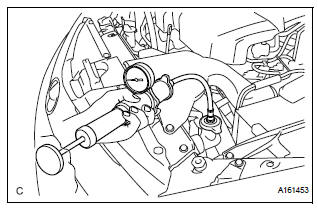Toyota Sienna Service Manual: Cooling system
On-vehicle inspection
1. INSPECT FOR COOLANT LEAK
| CAUTION: Do not remove the radiator cap while the engine and radiator are still hot. Pressurized, hot engine coolant and steam may be released and cause serious burns. |
NOTICE: Before performing each inspection, turn the A/C switch OFF.

(a) Fill the radiator with coolant and attach a radiator cap tester.
(b) Warm up the engine.
(c) Using a radiator cap tester, increase the pressure inside the radiator to 118 kPa (1.2 kgf/cm2, 17 psi), and check that the pressure does not drop.
If the pressure drops, check the hoses, radiator and water pump for leaks. If no external leaks are found, check the heater core, cylinder block and cylinder head.
2. INSPECT ENGINE COOLANT LEVEL IN RESERVOIR
(a) Check that the engine coolant level is between the LOW and FULL lines when the engine is cold.
If the engine coolant level is low, check for leaks and add "TOYOTA Super Long Life Coolant" or similar high quality ethylene glycol based non-silicate, nonamine, non-nitrite and non-borate coolant with longlife hybrid organic acid technology to the FULL line.
| NOTICE: Do not substitute plain water for engine coolant. |
3. INSPECT ENGINE COOLANT QUALITY
(a) Remove the radiator cap.
| CAUTION: Do not remove the radiator cap while the engine and radiator are still hot. Pressurized, hot engine coolant and steam may be released and cause serious burns. |
(b) Check if there are any excessive deposits of rust or scales around the radiator cap and radiator filler hole. Also, the coolant should be free of oil.
If excessively dirty, clean the coolant passage and replace the coolant.
(c) Install the radiator cap.
 2Gr-fe cooling
2Gr-fe cooling
...
Other materials:
Installation
1. INSTALL ECM
Install the ECM with the 2 nuts.
Torque: 5.5 N*m (56 kgf*cm, 49 in.*lbf)
Connect the 5 ECM connectors.
2. INSTALL ECM (with 10 speakers system)
Install the ECM and stereo components amplifier
with the 4 nuts.
Torque: 5.5 N*m (56 kgf*cm, 49 ...
Evaporative Emission Control System Incorrect Purge Flow
DTC SUMMARY
DESCRIPTION
The circuit description can be found in the EVAP (Evaporative Emission)
System (See page ES-409).
INSPECTION PROCEDURE
Refer to the EVAP System (See page ES-412).
MONITOR DESCRIPTION
The two monitors, Key-Off and Purge Flow, are used to detect malfunctions
relat ...
AUX Port/USB Port
Connect an iPod, USB memory device or portable audio player
to the AUX port/USB port as indicated below. Select ÔÇťiPodÔÇŁ,
ÔÇťUSBÔÇŁ or ÔÇťAUXÔÇŁ on the audio source selection screen and the
device can be operated via audio system.
Connecting using the AUX port/USB port
iPod
Open the cove ...

